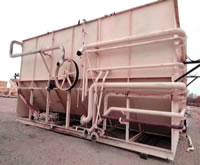Air Cooled Heat Exchanger
Introduction
Air-cooled heat exchangers are generally used a process system generates heat which must be removed, but for which there is no local use. A good example is the radiator in your car. The engine components must be cooled to keep them from overheating due to friction and the combustion process. The excess heat is carried away by the water/glycol coolant mixture. air-heat-exchang…hennai-tamilnadu. A small amount of the excess heat may be used by the car’s radiator to heat the interior. Most of the heat must be dissipated somehow. One of the simplest ways is to use the ambient air. Air-cooled heat exchangers (often simply called air-coolers) do not require any cooling water from a cooling tower. They are usually used when the outlet temperature is more than 20 deg. F above the maximum expected ambient air temperature. that can be used with closer approach temperatures, but often become expensive compared to a combination of a cooling tower and a water-cooled exchanger. Typically, an air-cooled exchanger for process use consists of a finned-tube bundle with rectangular box headers on both ends of the tubes. Cooling air is provided by one or more fans. Usually, the air blows upwards through a horizontal tube bundle.
Specifications of Air Cooled Heat Exchanger:
- Air-cooled heat exchangers space between the fan and the tube bundle is enclosed by a plenum chamber which directs the air.
- Air-cooled heat exchangers fans can be either forced or induced draft, depending on whether the air is pushed or pulled through the tube bundle.
- Air-cooled heat exchangers whole assembly is usually mounted on legs or a piperack.
- The fans are usually driven be electric motors through some type of speed reducer.
Applications of Air Cooled Heat Exchanger:
- Air-cooled heat exchangers speed reducers are usually either V-belts, HTD drives, or right angle gears.
- Air-cooled heat exchangers usually include a vibration switch on each fan to automatically shut down a fan which has become imbalanced for some reason The air-cooled heat exchangers are mostly used to the plant location and the ambient conditions do not allow an easy and economic use of other cooling systems.
Advantages of Air Cooled Heat Exchangers:
- No problem arising from thermal and chemical pollution of cooling fluids. Easy installation by bolted assembly.
- Flexibility for any plant location and plot plan arrangement (installation over other units).
- Reduction of maintenance costs.
Images:


